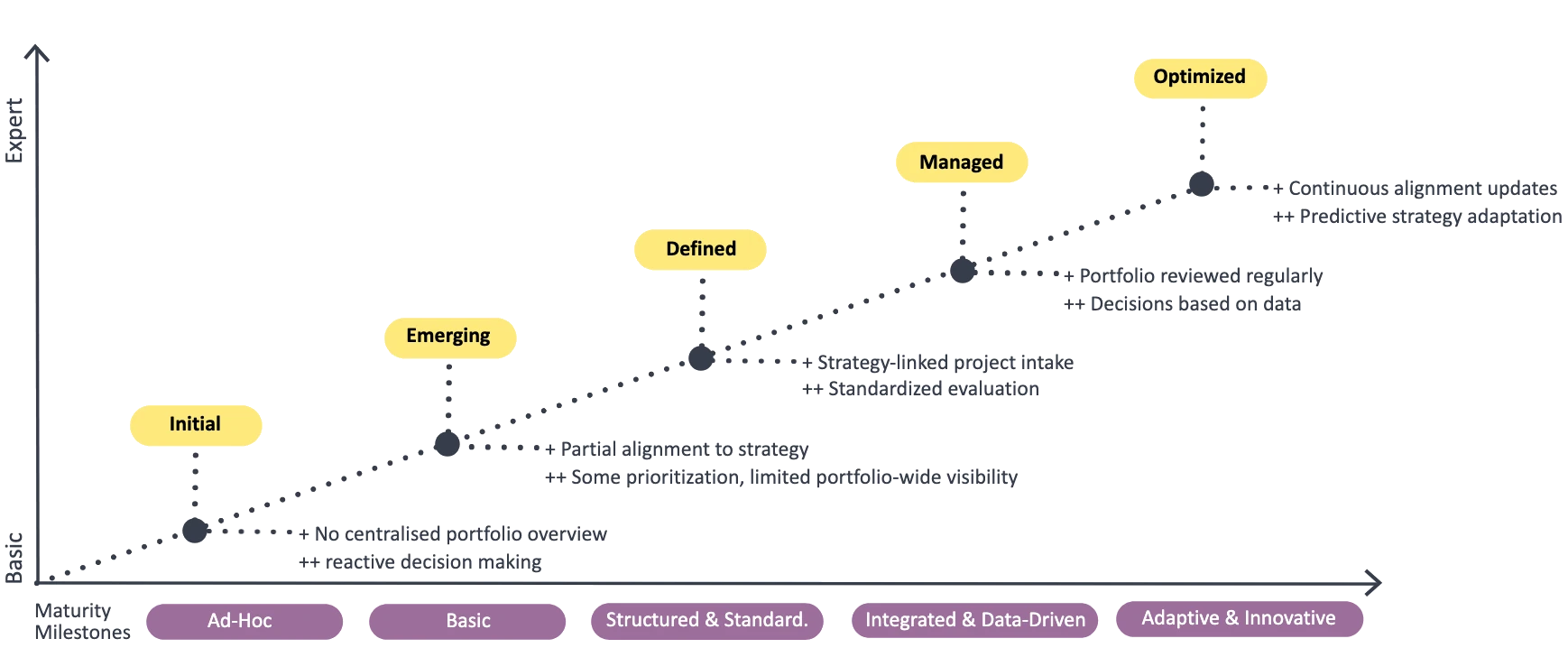
Strategic Portfolio Management (SPM) Maturity Assessment Framework

Five-Level SPM Maturity Model
This maturity model defines five levels of increasing capability and sophistication in Strategic Portfolio Management. Each level is described below, and in the subsequent matrix we show how the checklist areas map to these levels. An organization’s overall maturity may be at a single level or vary by capability. The goal is to progress stepwise through the levels – you cannot jump from initial to optimized overnight, but through gradual improvements in each area.

Level 1: Initial (Ad Hoc)
At this initial stage, strategic portfolio management practices are largely ad hoc or chaotic. There is little to no formal integration of strategy with project selection. Processes are informal, and decisions are made reactively or on an as-needed basis. There is no centralized portfolio oversight – individual projects may be managed well, but there is minimal coordination or standard process at the portfolio level. Organizations at this level often lack clear ownership of SPM, and success relies on heroic efforts rather than repeatable practices.
Level 2: Emerging (Basic)
In the emerging stage, the organization has recognized the importance of portfolio management and begun introducing basic structures. Some foundational processes are defined (for example, a rudimentary project intake process or occasional portfolio review meetings), but execution is inconsistent. There is partial alignment to strategy – leadership might set broad priorities, and some projects consider strategic objectives, but systematic prioritization is still weak. Governance exists in name, with some roles identified, but it may not be fully effective. Data is tracked mostly at a project level; portfolio-wide visibility is limited. Overall, practices are repeatable for certain teams or departments but not yet standardized across the enterprise.
Level 3: Defined (Structured & Standardized)
At the defined level, the organization has established structured and standardized SPM processes across the board. Strategic alignment is formalized: projects are required to link to strategic goals, and there are criteria to evaluate initiatives’ strategic fit. A governance framework is in place with a clear committee/PMO ownership and stage-gate approvals for new initiatives. The portfolio and initiative lifecycle is well-defined (from ideation to benefits realization) and is followed by all business units. Financial and resource management at the portfolio level are instituted – budgets are allocated according to strategic priorities, resource capacity is considered in planning, and major project inter-dependencies are documented and managed. Risk management and benefits tracking have defined procedures (e.g. each project must have a business case with expected benefits and a risk register, and these are reviewed at the portfolio level periodically). Data on projects and portfolio performance is being collected and reported in dashboards, though analysis is mostly descriptive. In summary, SPM practices are documented, consistent, and organization-wide – providing a foundation for more advanced optimization in later stages.
Level 4: Managed (Integrated & Data-Driven)
In the managed stage, SPM is fully integrated into broader enterprise management and decisions are heavily data-driven. The portfolio is actively managed to achieve strategic objectives: there are regular (e.g. quarterly) portfolio review meetings where executives adjust the portfolio based on performance data and strategic shifts. Governance is proactive – leadership uses established metrics and thresholds to know when to intervene. Resource capacity planning and financial management are integrated across the portfolio using software tools, enabling “single source of truth” visibility. Scenario planning (“what-if” analysis) is used before major decisions: for example, the PMO can model the impact of adding or deferring a project on budgets, timelines, and resources. Portfolio risk management is mature – an aggregated risk register or heat map is reviewed, and contingency or mitigation plans are in place for top risks. Benefit realization is tracked and reported long after project completion, feeding back into strategic planning (e.g. informing the next cycle of investments). The organization makes extensive use of KPIs and data analytics – dashboards provide real-time insight into portfolio health (financial, resource utilization, delivery performance, etc.), and this data is used for forecasting and decision support. At this level, the SPM process is not only standardized but also measured and controlled; the organization can predict outcomes with greater confidence and ensure alignment even as conditions change.
Level 5: Optimized (Adaptive & Innovative)
The optimized level represents a truly adaptive and continuously improving SPM capability, often enabled by advanced tools and insights (including AI). SPM at this stage is ingrained in the organizational culture – there is a continuous feedback loop where lessons learned and changing business dynamics drive ongoing adjustments to the portfolio and to SPM practices themselves. The portfolio is managed with an eye on innovation and agility: the organization can dynamically reallocate resources and re-balance the portfolio in response to real-time data or predictive insights. AI and advanced analytics are leveraged extensively – for example, AI assists in identifying emerging risks, optimizing project prioritization, or even generating initial business case drafts and status reports (freeing up human effort for higher-level analysis). The governance process is highly efficient and often augmented by intelligent automation (e.g. routine reporting or compliance checks are automated). All decisions are evidence-based, supported by forecast models and scenario analyses that consider complex interactions of financials, capacities, and benefits. At this level, the enterprise PMO is a strategic partner to leadership, continuously aligning the portfolio with strategy and driving maximum value. The focus is on optimization and innovation: not only are current processes fine-tuned for efficiency, but the organization also regularly introduces improvements and new capabilities (like adopting no-code workflow adjustments or new AI features) to stay ahead. In short, a Level 5 organization uses every available tool and feedback mechanism to intelligently manage the portfolio and rapidly adapt to change while achieving strategic objectives.
Read next